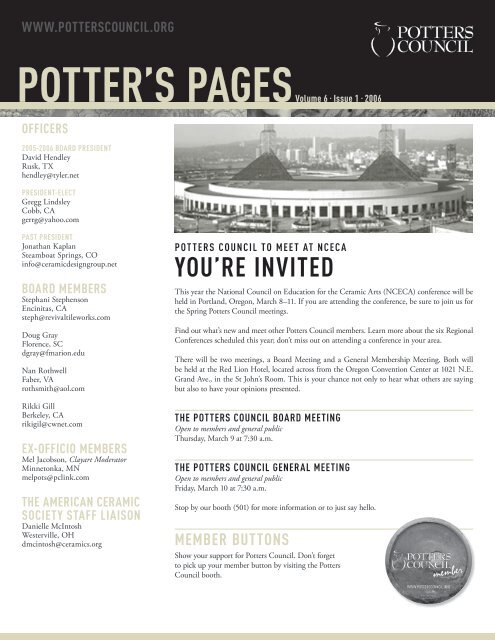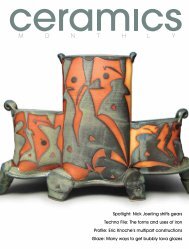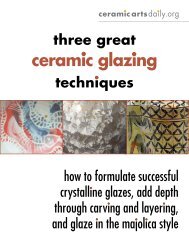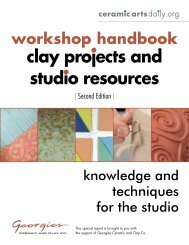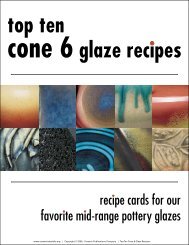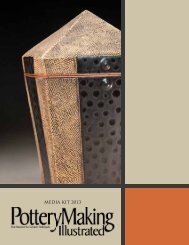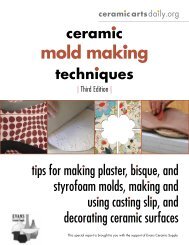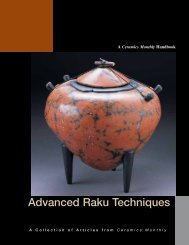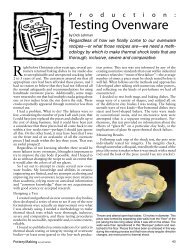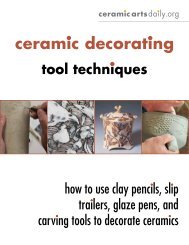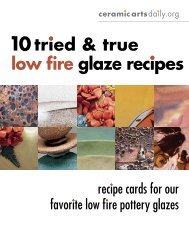Volume6. Issue1 - Ceramic Arts Daily
Volume6. Issue1 - Ceramic Arts Daily
Volume6. Issue1 - Ceramic Arts Daily
Create successful ePaper yourself
Turn your PDF publications into a flip-book with our unique Google optimized e-Paper software.
WWW.POTTERSCOUNCIL.ORG<br />
POTTER’S PAGESVolume<br />
OFFICERS<br />
2005-2006 BOARD PRESIDENT<br />
David Hendley<br />
Rusk, TX<br />
hendley@tyler.net<br />
PRESIDENT-ELECT<br />
Gregg Lindsley<br />
Cobb, CA<br />
gerrg@yahoo.com<br />
PAST PRESIDENT<br />
Jonathan Kaplan<br />
Steamboat Springs, CO<br />
info@ceramicdesigngroup.net<br />
BOARD MEMBERS<br />
Stephani Stephenson<br />
Encinitas, CA<br />
steph@revivaltileworks.com<br />
Doug Gray<br />
Florence, SC<br />
dgray@fmarion.edu<br />
Nan Rothwell<br />
Faber, VA<br />
rothsmith@aol.com<br />
Rikki Gill<br />
Berkeley, CA<br />
rikigil@cwnet.com<br />
EX-OFFICIO MEMBERS<br />
Mel Jacobson, Clayart Moderator<br />
Minnetonka, MN<br />
melpots@pclink.com<br />
THE AMERICAN CERAMIC<br />
SOCIETY STAFF LIAISON<br />
Danielle McIntosh<br />
Westerville, OH<br />
dmcintosh@ceramics.org<br />
6 • Issue 1 • 2006<br />
P O T T E R S C O U N C I L T O M E E T AT N C E C A<br />
YOU’RE INVITED<br />
This year the National Council on Education for the <strong>Ceramic</strong> <strong>Arts</strong> (NCECA) conference will be<br />
held in Portland, Oregon, March 8–11. If you are attending the conference, be sure to join us for<br />
the Spring Potters Council meetings.<br />
Find out what’s new and meet other Potters Council members. Learn more about the six Regional<br />
Conferences scheduled this year; don’t miss out on attending a conference in your area.<br />
There will be two meetings, a Board Meeting and a General Membership Meeting. Both will<br />
be held at the Red Lion Hotel, located across from the Oregon Convention Center at 1021 N.E.<br />
Grand Ave., in the St John’s Room. This is your chance not only to hear what others are saying<br />
but also to have your opinions presented.<br />
THE POTTERS COUNCIL BOARD MEETING<br />
Open to members and general public<br />
Thursday, March 9 at 7:30 a.m.<br />
THE POTTERS COUNCIL GENERAL MEETING<br />
Open to members and general public<br />
Friday, March 10 at 7:30 a.m.<br />
Stop by our booth (501) for more information or to just say hello.<br />
MEMBER BUTTONS<br />
Show your support for Potters Council. Don’t forget<br />
to pick up your member button by visiting the Potters<br />
Council booth.
2<br />
NEWSLETTER STAFF<br />
EDITOR<br />
Renée Fairchild<br />
rfairchild@ceramics.org<br />
MARKETING MANAGER, MEMBERSHIP<br />
Danielle McIntosh<br />
dmcintosh@ceramics.org<br />
PROOFREADER<br />
Jennifer Poellot<br />
jpoellot@ceramics.org<br />
ADVERTISE<br />
Reserve your space today and reach ceramics<br />
artists of all levels and interests.<br />
Contact Debbie Plummer<br />
dplummer@ceramics.org<br />
The official newsletter of The Potters Council of The American<br />
<strong>Ceramic</strong> Society<br />
© The American <strong>Ceramic</strong> Society<br />
The American <strong>Ceramic</strong> Society assumes no responsibility for<br />
the statements and opinions advanced by the contributions<br />
to its publications. Registered names and trademarks, etc., used<br />
in this publication, even without specific indication thereof,<br />
are not to be considered unprotected by law.<br />
L E T T E R F R O M T H E P R E S I D E N T<br />
POTTERY FOR PIXELS<br />
D AV I D H E N D L E Y, P O T T E R S C O U N C I L P R E S I D E N T<br />
With each passing year, it seems like I spend more and more time staring at a computer screen or<br />
otherwise fooling with some new technology or digital medium. I’m not complaining; both my<br />
personal life and my career as a potter are better as a result. The great thing about technology<br />
is that it “levels the playing field.” Here I am, out in rural east Texas, yet I can easily be in<br />
communication with people all over the world. I can take pictures of the pots from a firing of my<br />
kiln, format the pictures, put them on the World Wide Web, and offer them for sale all on the same<br />
day they are unloaded. I can design a new brochure, send the files to a printer in Cleveland and<br />
receive the finished product next week. It’s now possible to bypass the professionals whose expertise<br />
and equipment was needed to complete a project in the old predigital age.<br />
But (you knew there was a “but” coming, didn’t you), it seems like the more time I spend on these<br />
ancillary activities the less time I have to actually make pots. Interestingly and more importantly, it<br />
seems like spending a lot of time with a computer can actually change the way my mind works. I’ve<br />
found that it is difficult for me to get a good night’s sleep if I spend a lot of time with the computer<br />
in the evening. I keep seeing those little icons and wanting to click on them.<br />
In contrast, an evening working with clay usually portends a good restful night’s sleep. I think<br />
there are a couple of reasons. First, since there is actual physical work involved, even though it is<br />
not usually strenuous, it serves to make the body tired and ready for rest. Second, I think the brain<br />
is functioning in a different way when working directly with a material rather than with abstract<br />
representations of things.<br />
When I am in the throes of working on a series of pots and thinking about design and process,<br />
this mindset seems to carry over to other areas. I find myself thinking in three dimensions. It’s just<br />
a different way to perceive objects in the environment. I have always been interested in extruding<br />
as a means of forming clay. To broaden this idea even further, I have noticed several times when I<br />
have spent large amounts of time thinking about and designing extruder dies, that, again, my brain<br />
carries this way of looking at things over to other areas. I notice an object and immediately try to<br />
picture what a die to produce that shape would look like.<br />
I think this is why many people are drawn to clay as a hobby. With more and more jobs requiring<br />
abstract reasoning and manipulating pixels rather than concrete material, it’s a welcome change to<br />
grab some clay and shape it. But I’m worried that the younger generation is just not as interested in<br />
such things. They are so comfortable with technology, and it is so pervasive that it can seem like<br />
the only way to relate to the world and the only way to think. Statistically, we members of Potters<br />
Council are a pretty old group. The Board of Directors has been trying to come up with ideas for<br />
getting more young people involved with clay generally and the Potters Council specifically, so if<br />
you have any ideas, please share them with us.<br />
Spending time with clay can seem pretty old and unexciting compared to all the opportunities for<br />
trying the latest new thing. We need to bring back some balance. We all need to share our excitement<br />
about working with clay and do whatever we can to make sure more people, especially children, have<br />
opportunities to try their hands at crafts such as ceramics. I can tell you from experience that many<br />
kids know nothing about clay. But most, once they are shown a few things, like it, and in today’s<br />
world, any activity with kids that does not involve electronics is a good thing.<br />
Conversely, when talking with potters I’ve been surprised at how many Luddites there are out<br />
there who know nothing about all the modern resources that are available today. We may make<br />
things by hand, but learning how to use tools such as glaze calculation programs, the Internet, and<br />
digital cameras are well worth the effort. Maybe we need to institute a learning exchange program:<br />
pottery classes for computer lessons? Find a willing teenager and start a dialog!
GET TO KNOW MEMBERS<br />
CINDY GINTER &<br />
WENDY BIALEK<br />
SISTERS CREATING FOR AUTISM AWARENESS<br />
My sister Wendy and I have collaborated for the last year making jewelry and a portion of proceeds<br />
go to Autism programs in northwestern Illinois. Wendy began making jewelry to show support for<br />
her son, Zachary, who has autism. One day she asked me to make some Raku beads for necklaces<br />
she was making for this charity. We have been making beautiful jewelry together ever since!<br />
I live in Whitehouse, Ohio, and send beads to my sister in Algonquin, Illinois. The necklace shown<br />
here with my raku oblong beads, mixed with Lori Greenburg’s glass and Wendy’s design, was part<br />
of a charity Auction for Autism. This is truly beautiful in person. We have had great success so far<br />
selling our handmade custom-designed jewelry together. And all for a great cause!<br />
CAROLYN BURKE<br />
B I M I N I A R T C E N T R E , 2 4 2 . 3 47. 3 3 2 2<br />
My sister and I opened the Bimini Art Centre on the island of Bimini in the Bahamas about two<br />
years ago. Bimini is roughly 50 miles off Miami, and is 7 miles long and 700 feet wide. My sister<br />
does stained glass and fused glasswork while I do thrown and handbuilt pottery. The Art Centre<br />
offers a gallery of our work to the tourists. We also have a working relationship with the Bimini<br />
schools, where we hold demos and workshops.<br />
Last year, we had an opportunity to work with a group called Dolphins Bimini. They study the<br />
healing effect swimming with dolphins has on the disabled. They brought a group over to Bimini<br />
from near London, England. The participants were all diagnosed with different conditions. We<br />
were able to provide a pit fire on the beach and tie dying at the Art Centre.<br />
We also have had the opportunity to work with many international visitors. We had a group here<br />
with a psychotherapist/art therapist this summer. They were from Berlin, Germany. She brought<br />
two little girls into the Art Centre to do some clay on a day that the weather did not allow them to<br />
go out on the boat. The children did not speak English, so she translated for me and then for them<br />
during our two-hour session and successfully did a wheel piece and a handbuilt piece with each of<br />
them. Their stay was not long enough for the final firing so I finished the pieces and mailed them<br />
to Berlin. I recently got a message that they were received in good order, to the delight of the little<br />
girls. That email also included a request for some interactivity with a second group coming in the<br />
spring of 2006—probably another pit fire and some sand casting on the beach.<br />
We organized an “Art on the Island” festival on Memorial Day for the past two years and are in<br />
processing of organizing our third one for 2006. Last year, we had seven artists from Andros, two<br />
from Nassau and three from Bimini. We hope to build on this to make it an event of merit in the<br />
Bahamas and for Bimini. We think we have a rather unusual atmosphere in which to work and<br />
unique opportunities to relate to visitors to our community.<br />
The Potters Council is sad to report that as the Potters Pages were going to press, we learned that<br />
Carolyn Burke is no longer with us. She passed away in a plane crash at the end of December off<br />
the coast of Miami. She will be missed.<br />
MEMBERS ONLINE<br />
GALLERY<br />
Don’t forget! You can view your work<br />
and the work of other council<br />
members without ever having to leave<br />
the comfort of your home.<br />
Potters Council members should take<br />
advantage of the online gallery at<br />
www.pottersouncil.org. Please send<br />
1–3 digital images of your work,<br />
along with your name, city, state and<br />
member number. The images should<br />
be either jpegs or gif, 72 dpi, rgb<br />
format and should have a maximum<br />
width of 225 pixels (3.125 inches).<br />
Please e-mail digital images to Renée<br />
Fairchild: rfairchild@ceramics.org.<br />
3
4<br />
POTTERS COUNCIL CONFERENCE IN…<br />
SUNNYVALE, CALIFORNIA<br />
Mother Earth Clay Art Center is proud to host “ClayScapes,” the April 2006 Potters Council<br />
Conference with the theme of surface design. We have invited nine gifted ceramics artists:<br />
Joe Battiato, Rikki Gill, Doug Gray, Bob and Sandy Kinzie, Karen Massaro, Elaine<br />
Pinkernell, and Bill Shinn. Each artist will demonstrate various techniques to enrich the<br />
surface of your clay artwork. Our keynote speaker will be Robin Hopper. Techniques to<br />
be explored in the four-day conference will include brushwork, carving, thrown surface<br />
treatment, layering of colored clay, image transfer, impressions and rolling stamps.<br />
The primary format for this conference will be two artists working side by side, with each<br />
artist alternately discussing the techniques they are demonstrating. Each pair of artists<br />
will work for a full 90-minute period, followed by a short break for refreshments and<br />
discussion between sessions. The complete schedule of events can be found online at<br />
www.potterscouncil.org/clayscapes.<br />
The conference will be kicked off with a reception at 5pm on Thursday evening April 20,<br />
hosted by Orchard Valley <strong>Ceramic</strong> <strong>Arts</strong> Guild and Chinese Clay Art. The subsequent<br />
ClayScapes sessions will run throughout the day on both Friday and Saturday (April<br />
21–22 from 9am to 5pm). Friday evening we will provide a sumptuous sit-down dinner<br />
with Robin Hopper. On Sunday, April 23, there will be a special farewell brunch before<br />
everyone heads home to explore their newfound skills and techniques.<br />
For more information regarding this conference, please contact Danielle McIntosh, Marketing<br />
Manager, Potters Council, 614-794-5827 or dmcintosh@ceramics.org.<br />
CALL FOR MARKS/SIGNATURES<br />
Potters Council is compiling an archive of potter’s marks, like those complimenting feature<br />
articles in <strong>Ceramic</strong>s Monthly. This collection is slated for a future publication on Potter’s<br />
Marks & Signatures. Don’t miss out on getting your mark published, submit today.<br />
Submit to: Jennifer Poellot, 735 <strong>Ceramic</strong> Place, Suite 100, Westerville, OH 43081.
MARK YOUR CALENDARS AND START PLANNING<br />
FOR THE FOLLOWING UPCOMING CONFERENCES<br />
2006 CONFERENCE SCHEDULE<br />
CLAYSCAPES<br />
Surface Design Conference<br />
Mother Earth Clay Art Center, Sunnyvale, California • April 20–23, 2006 (see previous page)<br />
ENGLISH CONNECTION<br />
Functional Pottery with American and British Potters<br />
Stonewall Jackson Hotel & Conference Center and Mary Baldwin College, Staunton, Virginia<br />
June 1–4, 2006<br />
The link between British and American pottery will be the topic this June when the Potters<br />
Council hosts this regional conference. Six potters – three British and three Americans who trained<br />
in England will demonstrate and talk about their work during The English Connection.<br />
ALL FIRED UP<br />
Alternative Firing Techniques<br />
Adelphi University, Garden City, NY • July 6–9<br />
Coming this July, “All Fired Up: Alternative Firing Techniques” in Garden City, New York. This<br />
exciting workshop is comprised of eleven nationally known alternative ceramics artists. Alternative<br />
includes raku, pit, Anagama, single, and soda/salt firing to name a few. This conference will give<br />
you a chance to watch how these artists make and fire their work, and then you will fire a few of<br />
your own pieces on site. Spend some time learning about printmaking on clay with Mitch Lyons,<br />
watch Randy Brodnax and Don Ellis raku the night away, or hear stories about life as a potter with<br />
Mel Jacobson. Afterhours, lectures will be given by Long Island’s own Professor Hecht who wrote<br />
about George Ohr, or Steven Hill, master of the single firing. You will also have an opportunity<br />
to visit Long Island’s only Anagama kiln. So, while it is a cold winter, start thinking about your<br />
summer and join us for this unforgettable event.<br />
SOUTHERN FRIED CERAMIC SURFACES SYMPOSIUM<br />
All about Surface Design • Hosted by Doug Gray > more details to follow<br />
Francis Marion University, Florence, South Carolina • July 27–30, 2006<br />
MORE THAN SKIN DEEP<br />
Surface Decoration Hits the Midwest • In conjunction with AMACO > more details to follow<br />
Indianapolis, Indiana • September 13-16, 2006<br />
This conference will feature six presenters who are either teachers or professional ceramic artists<br />
with topics including: underglaze decorating, printing clay on clay, Majolica decorating, clay<br />
decorating, underglaze plaster printing. BRENT and AMACO wheels and AMACO CLAY will<br />
be available for the attendees for the conference. After the lecture series, attendees will visit the<br />
“CLAY FEST SHOW” at the University of Indianapolis. Attendees can view the exhibit at the<br />
AMACO/Brent Gallery, which would include works by the presenting artists and members of the<br />
Potters Council.<br />
PATE DE VERRE<br />
Glass Casting for Potters and Sculptors • In conjunction with Flat Rock Studios > more details to follow<br />
Fayetteville, Arkansas • November 2-5, 2006<br />
Demonstrations at the Pate De Verre Conference will include model making in wax and clay, the<br />
making of refractory molds, charging (filling) molds with glass, and also information on firing<br />
schedules, annealing, glass finishing and polishing.<br />
HOST A REGIONAL<br />
CONFERENCE<br />
5<br />
How exciting would it be to host a<br />
conference built around a theme that truly<br />
gets you energized. Gather your own<br />
community of associates and fellow potters<br />
in one setting to share techniques and<br />
presentations that would be hard pressed to<br />
find any other place. Sounds great! A<br />
conference in your area, highlighting your<br />
expertise and you’ll have help putting it<br />
together. That’s right, you’ll have plenty of<br />
help from the Potters Council staff to<br />
organize your event.<br />
If the idea of hosting a conference interests<br />
you, please let us know! We welcome your<br />
submissions.<br />
If you have more questions, please feel<br />
free to contact me, or you may submit your<br />
proposal to dmcintosh@ceramics.org.
6<br />
2006 EVENTS/EXHIBITIONS<br />
TOLLAND, CONNECTICUT<br />
Birch Mountain Pottery, a combined studio/gallery/classroom, is celebrating its 20th year. Potter/<br />
owner Susan Gerr announced a 20th Anniversary Exhibition to be held at the Tolland Art Center<br />
May 12–14, 2006. Gerr’s work, as well as past and present student’s work, will be exhibited. Part<br />
of the proceeds will benefit “The Hole in the Wall Gang Camp,” located in Ashford, CT. <strong>Daily</strong><br />
demonstrations also are planned. For more information, call Birch Mountain Pottery (860) 875-<br />
0149 or see www.birchmountainpottery.com<br />
CRETE, GREECE<br />
Omma Center of Contemporary Art is organizing the Fourth International Art Festival from June<br />
15–30, 2006 at the NEORIA public exhibition center in the Old Town of Chania, Crete, Greece.<br />
It will be the largest art exhibition ever held in Chania and one of the largest ever held in Greece.<br />
Deadline: March 15, 2006. Open to all media. Juried from 5–10 images in JPG or Gif format<br />
(no more than 250 kb each). Each artist will participate with two works (no size limit). Artist fee:<br />
€350 (US$422). Gallery (group of 4 artists) fee: €1300 (US$1570). Only artists who received an<br />
email for acceptance can submit the application form to confirm their interest. One of the works<br />
and a short biography of each artist will be included in a full color catalog. Each artist will get<br />
two copies of the catalog for free. Contact Omma Center, 43 E. Venizelou, 731 32 Chania, Crete,<br />
Greece; tel/fax (30) 2821042100 or 1221 State St., Santa Barbara, CA 93101; tel/fax (805) 963<br />
4606; e-mail omma@omma.gr or see www.omma.gr.<br />
SANTA BARBARA, CALIFORNIA<br />
Sculptures by Salvador Dali and Pablo Picasso will be on view February 1–26 at Omma Center of<br />
Contemporary Art, 1221 State St., Santa Barbara, CA 93101.<br />
BRIGHAM CITY, UTAH<br />
June 19–30 “Clay Crewe Workshop.” Glaze theory and Formulation with Dave Finkelnburg;<br />
tile, architectural ceramics with Stephani Stephenson; cone 6 glazes, electric fire, Mason stains<br />
with Alex Solla; website development with Gail Phillips, throwing boot camp, kilns, firing with<br />
Lee Burningham; and logos, art/chop design with Zan Burningham. Fee: $800; one week only,<br />
$450. Limit of 30. Contact Lee Burningham (435) 881-0151; e-mail lee@claycrewe.com or<br />
claypotts@aol.com.<br />
MINNEAPOLIS, MINNESOTA<br />
“Tiles of the Northern Plains: Building on Tradition” is being presented by the Handmade Tile<br />
Association and the Tile Heritage Foundation in Minneapolis, September 13–17, 2006. The focus<br />
of the conference will be on the remarkable achievements of local tilemakers and mosaic artists<br />
as well as the historical traditions that have nurtured this development. There will be tours, both<br />
guided and self-guided; presentations by noted tile historians; studio demonstrations and workshops<br />
in which participants will get a firsthand view of all the goings on; and exhibitions—at least two<br />
planned at this time—that will feature contemporary tile work and its historical predecessors.<br />
DIX HILLS, NEW YORK<br />
In conjunction with “All Fired Up” Potters Council Conference (July 8–August 13), the Art<br />
League of Long Island will be hosting a juried exhibition, “Patterns in Clay.” Juried from up to 7<br />
slides or CD. Fee: $15. Contact Ruth Sachs, Art League of Long Island, 107 E. Deer Park Rd., Dix<br />
Hills 11746; e-mail ruth@ruthsachs.us; see www.artleagueli.org; telephone (631) 462-5400.
PART III<br />
RHEOLOGY<br />
G R E G G L I N D S L E Y<br />
This is the third and last article dealing with rheology, a tool that will<br />
help you get your glazes to do what you want them to do, every time.<br />
Rheology is the science of using specific gravity and viscosity to make<br />
consistent glaze batches. This article deals with flocculation and its<br />
opposite, deflocculation, and their relationship to glaze making.<br />
When does one use a flocculant or deflocculant? The answer is after you<br />
have determined the correct specific gravity and the correct suspension,<br />
but the viscosity is off. In most cases, once you are happy with the specific<br />
gravity and the suspension, you should not need to do anything else.<br />
Flocculation, according to Hamer in the Potters Dictionary of Materials<br />
and Techniques, is the altering of the physical nature of a suspension of<br />
particles so that they no longer repel one another but aggregate into larger<br />
particles, called flocs.<br />
A flocculant is a soluble material that is added to a suspension to increase<br />
its viscosity. Increasing the amount of a flocculant has progressively<br />
more effect, but a point is reached where further increases stop working.<br />
Flocculation is used by the potter to make a suspension more permeable<br />
so that it dries more quickly; to thicken slips for use on clay; to thicken<br />
glazes for use on hard bisque ware; and to thicken glazes in a way that<br />
keeps the coarser minerals in suspension.<br />
Suspensions that contain large amounts of clay are slow to settle and often<br />
produce slippery, dense sediments. The clay particles are packed together<br />
in what is called a card-stack structure (picture a new deck of cards). Here<br />
the plates lie flat upon one another. As the water dries from the surface<br />
of the clay, it pulls the plates together, creating an impermeable layer<br />
through which water cannot pass. This creates problems such as slips and<br />
glazes that will not dry on pots and slip that cannot be dried to plastic<br />
clay. Also, clay slips and glazes are sometimes too fluid to give a coating<br />
of sufficient thickness. The solution is to add a small amount of vinegar<br />
or calcium chloride in solution. Epsom salts (magnesium sulphate) and<br />
sodium chloride also can be used.<br />
Sometimes overfired bisque can cause a coating of insufficient thickness,<br />
where the ware cannot absorb sufficient water. Flocculation will give a<br />
more viscous and bulkier glaze, and will give a thicker layer. Using Epsom<br />
salts or calcium sulphate (plaster of Paris) can improve results with glazes<br />
containing colloidal clay, like ball clay or bentonite. Glazes that contain<br />
very small amounts of clay, like fritted glazes, do not respond well. They<br />
can be temporarily flocculated by the use of gelatin. Gelatin should be<br />
dissolved in hot water and added until the desired viscosity is reached.<br />
The effect will last a few hours.<br />
Let’s take a look at deflocculation now. This is the action of dispersing<br />
the fine clay particles in a slip or glaze so it becomes more fluid. Slips,<br />
which are used in casting and are therefore high in clay content, can, with<br />
a deflocculant, retain a high proportion of clay while remaining fluid<br />
enough to be poured.<br />
Deflocculation is achieved by adding suitable soluble alkalis to clay<br />
suspensions. Increasing fluidity without loss of bulk is important in the<br />
slip casting process. These added alkalis exchange their ions (charged<br />
atoms) with those of the clay particles so that the clay particles are all of a<br />
similar powerful electrostatic charge. In this state, they repel one another<br />
and are unable to floc.<br />
Deflocculatory materials can only act when there is sufficient water<br />
for them to go into solution and thus release their ions for exchange.<br />
Also, they can only produce results when the solid in suspension is of<br />
colloidal size. Clays, particularly fine clays like ball clay and bentonite,<br />
give good results, but other minerals such as feldspar are hardly affected.<br />
Some ground materials intended for fine dispersion have good results,<br />
like zirconium silicate. Coarse materials like flint show no reaction to<br />
deflocculants but some to flocculants. So a suspension must be a colloidal<br />
suspension and the deflocculant a solution, although it can be weighed<br />
and calculated as a solid. Potters often use sodium carbonate (soda ash),<br />
sodium silicate or Darvon-7.<br />
If your glaze or slip is of the proper specific gravity but the viscosity is<br />
wrong, use a flocculant or a deflocculant. Use a flocculant if it needs to<br />
be more viscous or thicker, and a deflocculant if it needs to flow more.<br />
This will help you achieve the balance needed to allow your glaze to be<br />
the same as it was the last time, as well as the next time.<br />
7
8<br />
Doug, seen here with his two-year-old daughter Kiran.<br />
Photo taken by his four-year-old son, Bibek.<br />
ALL I NEED TO KNOW IN LIFE<br />
I LEARNED FROM CLAY<br />
D O U G G R AY<br />
I don’t know if a scientific study has ever been conducted, but I bet you could arrive at some rather<br />
interesting psychological profiles based on the human response to fortune cookies. I know I have, on<br />
occasion, completely ignored that barely sweetened morsel brought with the bill at the end of a meal.<br />
But, more often than not, I succumb to the temptation of that crunchy casing and am pleased to find<br />
that rare message inside; a message that speaks so clearly and pointedly to my own condition that I<br />
feel as if fate itself has orchestrated the proper planetary alignment necessary to bring this bit of crisp<br />
dough to my lips and this bit of wisdom to focus in my mind.<br />
All right, maybe I have an overactive imagination. Maybe, I eat way too much garlic chicken at<br />
the Chinese restaurant near the university where I teach. But have you ever considered what a<br />
wondrous coincidence it is that a such a concise message,<br />
originating a great distance away in both distance and<br />
time, could have any specific significance to your own<br />
life?<br />
Anyone who has had more than a casual conversation<br />
with me in the past three years has heard that my wife<br />
and I are proud adoptive parents. Our problems with<br />
fertility and the consequential pursuit of adoption ceased<br />
to be private long ago as the local paper has published<br />
not one but three articles detailing our journey to<br />
parenthood. So I can tell you now, with all openness,<br />
that in the arduous years it took to start our family, my<br />
life began to feel like an immense maze fraught with<br />
all too many twists, turns and inevitable dead ends. I<br />
found myself using the term “maze” in conversations to<br />
describe the quite literal feelings I experienced of being<br />
lost in the process. Then one day, after finishing a meal<br />
at Jin Jin’s restaurant, I came across this fortune cookie<br />
that quietly professed, “You will soon find your way<br />
through the maze.” I was . . . well, amazed, to say the<br />
least. There was no celestial intervention or profound<br />
epiphany but at that moment, using my own words, this<br />
bit of cookie reassured me in the most direct way that “this too shall pass.” Several weeks and a<br />
maze-shaped tattoo later, we received a referral for our son Bibek, a beautiful little two-year-old<br />
boy from Kathmandu, Nepal. And the rest is, as they say, history.<br />
By this point, you may be asking yourself what any of this has to do with clay? Well, I’ve been<br />
inspired by the fortune cookie method of imparting wisdom, and I’ve tried to implement its<br />
simple approach to teaching ceramics in the classroom. Despite the sensuous nature of the<br />
material, ceramics in the classroom doesn’t have the same appeal as say “Sex in the City.” But I’m<br />
a firm believer that if four single women in New York can learn about themselves through their<br />
relationships with men, then I can learn about myself by handling clay.
My first ceramics teacher once told my class that, “If you pay attention, the clay will teach you<br />
all you need to know.” Don’t assume for a second that he was relinquishing his responsibilities<br />
as a teacher. On the contrary, he was leading us to the understanding that there is a relationship<br />
between the medium and the maker, and to really learn how to manipulate a material and express<br />
yourself through it, you must first know what it can and can’t do. This is as true for clay as it is<br />
for farming, baking a loaf of bread, selling a car, or for that matter brain surgery or travel in space.<br />
The more you know your material, the more practiced your skills, the more successful your efforts<br />
will be. So the next time someone tells you that working in clay isn’t rocket science, tell him or her<br />
how very wrong they are.<br />
At that time, I may not have understood the subtlety of my first lesson from clay but I did get<br />
the broad picture. It’s simple physics. For every action there is a reaction. Each time I touch the<br />
clay—pull it, stretch it, paddle it, wet it, dry it, break it—for each of my own actions there is a<br />
response from the clay. If I don’t like the response I’m getting, then I need to re-evaluate my own<br />
actions. Consider this chapter one in the as-yet-unwritten book, Everything I Need to Know in<br />
Life I Learned from Clay. It is essentially the fortune cookie lesson following the nourishing meal<br />
that comes from any creative expression. And the lesson states, “With every touch you make an<br />
impression.” Touch can occur in a multitude of ways, with fingers, tools, brushes or spray guns.<br />
And these actions can occur at any stage within the process from wet to bone dry to bisque and<br />
glaze, and beyond. All your actions leave marks and these marks stand as a visual record of the<br />
hand of the maker. The question is, however, whether all these visual records are pertinent to the<br />
message you are trying to convey to the viewer. The key is simply to be aware of touch—gauge and<br />
evaluate the effects. A simple lesson, don’t you think? Now, apply that same attitude to your life in<br />
general. Keep in mind that everything you do and say has an effect on the people, places and things<br />
around you, even the things that are left undone or unsaid—all of your actions, reactions and<br />
inactions. In writer’s terms, you are an adjective and you modify the nouns of your existence.<br />
I’m writing this to you from an internet cafe situated between the Nirvana Gardens Hotel and the<br />
Tibet Guest House in Kathmandu, Nepal. It seems that one never really emerges from the maze<br />
of life. Rather one’s objectives are met or perhaps they shift and you find yourself again heading<br />
into uncharted territory. Once more I find myself on the other side of the globe in search of a<br />
child. A girl this time, also two years old, and the adoption process has just been completed. As I<br />
hold her these first times, I am reminded of that lesson I learned from clay, that there is immense<br />
power in touch. I have willingly taken on a great responsibility, that of making a good impression<br />
on her life and on the life of my son as well. My children’s touch on my chin or tug on my ear<br />
warms me to the core for I know the touch of my children will also change me in ways I can not<br />
fully comprehend.<br />
Yet as a father, a teacher and a shaper of clay, the best I can hope for is to be that rare fortune cookie,<br />
to be able to say the right thing at the right time to the right person. And in doing so, to pass along<br />
some tidbit of wisdom or significance. The lessons learned from clay have ramifications far outside<br />
the realm of the studio. But just as the process of learning about clay informs the other pursuits of<br />
life, so should the lessons of life inform one’s creative pursuits in clay. After all, they are all really<br />
just one and the same. And that is all I need to know about that.<br />
Doug Gray is a board member of the Potters Council and the Florence Regional <strong>Arts</strong> Alliance. He<br />
teaches ceramics, ceramic sculpture, and three-dimensional design at Francis Marion University in<br />
Florence, SC. He still enjoys garlic chicken at Jin Jin’s restaurant and reads his fortune every time,<br />
whether he eats his cookie or not.<br />
9
10<br />
T H E A M E R I C A N C E R A M I C S O C I E T Y ’S<br />
VIRTUAL MUSEUM<br />
When was the last time you checked out the American <strong>Ceramic</strong> Society’s (ACerS) website,<br />
www.ceramics.org? If it has been awhile, you are missing out on seeing an exceptional<br />
collection of ceramics online. The Ross C. Purdy Museum—home to the ACerS ceramics and<br />
glass collection, the Spencer Davis/<strong>Ceramic</strong>s Monthly (1953–1997) collection and the <strong>Ceramic</strong>s<br />
Monthly collection (1998–2006)—is now a virtual museum.<br />
Go to www.ceramics.org and click on “Ross C. Purdy Museum of <strong>Ceramic</strong>s” Now Online<br />
on the right side of the page. The collections are broken down into categories and you can<br />
search them however you would like. Maybe you only want to look at cups, or works with<br />
celadon glaze, or pieces that were purchase awards. The possibilities are endless. Each piece<br />
has a detailed description and clicking on the thumbnails can enlarge the images. Just click the<br />
search button and enjoy this tremendous resource.
BOARD MEMBER-AT-LARGE<br />
CANDIDATES<br />
W W W. P O T T E R S C O U N C I L . O R G / E L E C T I O N S<br />
Stephani Stephenson will be leaving the board this year, as her term is up. We hope she will remain actively involved in the Potters<br />
Council. Stephani, we thank you for you service.<br />
There are three candidates for a new at-large board member. The candidate with the most votes will be elected for a three-year term<br />
beginning March 2006.<br />
MARK ISSENBERG, RISING FAWN, GA<br />
I’m a retired Firefighter and have a degree in Fire Science. I’ve been involved in clay since the ninth grade. When I graduated from<br />
high school in 1968, I spent the summer studying with Charles Counts in Rising Fawn, Georgia. That summer I focused my life on<br />
making pottery. The following summer, I was Charles Counts’ resident potter. I ended up in Miami, where I became a firefighter for<br />
the city of Hialeah for 18 years and continued making pots, doing mostly ash glazes.<br />
I attend NCECA every year and also the Alabama Clay Conference. I am the past president and current vice president of the Georgia<br />
Clay Council, which I helped found. My wife Nona and I live in Rising Fawn, where I have a studio and a gallery. I am a member of<br />
the Southern Highland Guild. I think it’s great that the clay community has the Potters Council to speak for them on a national level.<br />
I would like to get involved in the process of representing the group as I feel like I know the attitudes and concerns of many potters.<br />
WAYNE SEIDL, KEY WEST, FL<br />
I have spent much of the past fifteen years learning clay, reading everything I can find on all aspects of the medium that interested<br />
me. This often leads me to trying and experimenting on a daily basis. While I am not a professional potter making my living from<br />
sales of pots, sculpture or art, I am still heavily involved and believe it to be my vocation rather than a hobby. The demands of running<br />
successful businesses for the past twenty years have kept me from full-time involvement as a professional potter, a situation that happily<br />
will be rectified shortly with my retirement.<br />
As a business owner and operator, I have the ability to organize and successfully complete projects in the face of sometimes overwhelming<br />
adversity. Because clay is the medium I love and not simply a hobby, I believe I can bring a large amount of energy and commitment<br />
to the Board. I would love to see the Potters Council become much more than what it presently is, and would be willing to work hard<br />
to ensure that.<br />
LISA SKEEN, SUMMERFIELD, NC<br />
I received my Bachelor’s degree from the University of North Carolina at Greensboro in 1999. I have worked in clay for over ten years as<br />
a professional potter and art teacher. Currently, my work features an eclectic mix of traditional functional ware with funky additions,<br />
alterations and textures, as well as a good bit of horsehair raku. I am interested in serving on the Potter’s Council to help give the<br />
membership more for its money. I would like to see more of the regional workshops happening, as well as other benefits such as some<br />
form of affordable health insurance coverage. The Potters Council has a lot to offer the studio potter and this is a good opportunity<br />
for me to give back to the group.<br />
Place your vote for the next at-large board member by checking the box next to the candidate you wish to vote for. Please sign and provide<br />
your member number below, or vote online at www.potterscouncil.org/elections and return by March 4, 2006.<br />
Member Number Print Name<br />
Signature<br />
Return your completed ballot to Renée Fairchild, Potters Council, 735 <strong>Ceramic</strong> Pl., Ste. 100, Westerville, OH 43081; fax to (614) 891-8960;<br />
or vote online at www.potterscouncil.org/elections. Deadline: March 4, 2006<br />
11
735 <strong>Ceramic</strong> Place, Suite 100, Westerville, Oh 43081<br />
CONTRIBUTE<br />
It’s FREE! Advertise a workshop or exhibition, share ideas, suggestions or comments. Get involved and submit your information<br />
today! Member participation is key to the success of Potter’s Pages. Please send information to rfairchild@ceramics.org and share<br />
your news with 3000 members.<br />
Deadline for the next Potter’s Pages is April 7, 2006.<br />
11 BOARD CANDIDATES<br />
ANNOUNCED<br />
8ALL I NEED TO KNOW IN LIFE<br />
I LEARNED FROM CLAY<br />
6 • Issue 1 • 2006<br />
1POTTERS COUNCIL SPRING<br />
MEETINGS ANNOUNCED<br />
POTTER’S PAGESVolume<br />
WWW.POTTERSCOUNCIL.ORG


